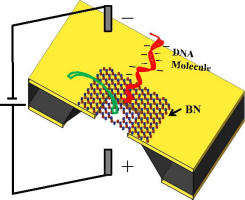Time:2013-06-19ClickTimes:
Nanopore DNA sequencing is one of the most promising technique toward the
third generation fast, low cost, and direct reading long chain DNA
sequencing, which is extremely significant in understanding disease,
inheritance and for personalized medicine. Negatively charged DNA molecules
in solution could be dragged through a nanopore connecting two fluidic cells
as the only channel when a biased voltage was applied. DNA translocation
through nanopores would cause a sudden drop in the ionic current due to DNA
occupation of the pore. Two parameters extracted from the ionic current
drop, the drop magnitude (event depth) and the drop duration time (event
length), can give corresponding information of the translocated DNA.
One of the main challenge remained in solid-state nanopore DNA sequencing
is that the membrane containing nanopore is too thick (>10 nm) to read
single base information. BN has high temperature stability, low dielectric
constant, high mechanical strength, large thermal conductivity, high
hardness, and high corrosion resistance. BN has been widely used in
high-performance electronic devices integrated with graphene due to a high
band gap and low mismatch with the graphene lattice. Moreover, the thickness
of a single layer f BN is comparable to the spacing between nucleotides in
ssDNA, which makes it a competitive candidate to realize single-base
resolution on superthin nanopore structures.
Recently, associate Professor Qing Zhao, and graduate student Song Liu in
Prof. Dapeng Yu’s group have made new progress in this field after 4 years
efferts. They demonstrate the first report of DNA translocation through BN
nanopores: double-stranded DNA molecules were successfully translocated
through highquality two- or three-layer BN nanopores. The BN nanopores
showed much higher sensitivity in DNA single-molecule detection compared
with SiN nanopores. The effective thickness of BN is around 1.1 nm, from TEM
analyses and numerical simulations, indicating a high spatial resolution can
be achieved by using BN nanopores. The corresponding results have been
published in Advanced Materialshttp://dx.doi.org/10.1002/adma.201301336.

|

|

|

|
Figures: Scheme of BN nanopore measurements setup; TEM image of BN
nanopore;
current blockage versus event length; simulation of the
pore length and radius.
|
This work is supported by National 973 projects from the Ministry of Science
and Technology, the National Natural Science Foundation of China and State Key
Laboratory for Mesoscopic Physics.
